By: Brandon Ross- President, Cambodia
My brother, while he was creating our Bangkok office about eight years ago, came upon the realization that how people get around a city says a lot about the city. From this realization came our “Public Transit Tour” of Bangkok where guests explore the highlights of the city, using public transit to get around.
I have been working on creating a similar tour in Yangon and have found the transportation here to be very similar and yet very different to that in Bangkok. The taxis in Burma are at that stage where, if they were just a little bit older, they could be marketed at auctions as antiques. There is no meter; the driver simply tells you how much the ride will cost. As going to a place and coming back have rarely been the same price, I have yet to figure out how to estimate what a ride should cost. A few newer, very small taxi cars do exist which I do not recognize the make of, they may be either Indian or Chinese made, but the vast majority of taxis are very old Nissan or Toyota sedans. Some have the steering wheel on the right and some on the left, but all make me think my 16 year old car in Cambodia is still a baby. I have heard they have to retire taxis when they are 40 years old, but it does not seem that law is being enforced. I have honestly ridden in a taxi where, under my feet, the floor had rusted out to the point where there was a baseball-sized hole that gave me a view of the road below. More than once my taxi driver has had to open the door from the inside to let me in or I have had to reach out the window to let myself out. Despite the interesting condition of their cars, all the drivers have been very nice and about the most honest group of taxi drivers I have found thus far. The other thing I still find so strange is that as old as all the cars are, and as many vehicles as there are, this city does not allow motorbikes or bicycles on the roads. Apparently, it is also illegal to honk in Yangon, another shocker as in Southeast Asia it is typical to honk to let people know you are coming, to let people know you are turning, to try to hurry up the thousand cars in front of you, or just to check that your horn is still working because it has been a couple of minutes since you last hit it.
The buses in Yangon are about as old as the cars. They stop at a bus stop just long enough for people to hop off and people to hop on, though I have seen a number of people hop on while the bus is still slowly rolling so the term bus ‘stop’ is a bit of an exaggeration. I don’t know if the doors on the bus both open and close, but they remain open even while the bus is in motion and some young guy collects the small fee for riding the bus. The fee collector wears no uniform and gives you no ticket in exchange, so the only thing that makes him seem official is he has a handful of small Kyat (local currency). The lack of motorbikes, bicycles, subways, and other forms of transportation in Yangon means there are lots of buses. On a busy evening, not wanting to ride on a bus that could be classified as standing room only before they picked up yet another twenty people, I decided to just wait for the next bus. The next bus came less than a minute later with again more people than it should hold. To try my luck, I waited maybe a full minute for the next bus, which did happen to have standing room, and hopped on. I think the frequency of buses at “bus almost stops” in Yangon is the most I have ever seen in a city.
The old buses and old taxis lead me to what is probably the oldest form of transportation in the city, which is a trickshaw. Unlike the cyclo in Cambodia and Vietnam, where you sit in the front and a man peddles behind, this is a bicycle with a side cart attached where one person sits almost parallel to the man who peddles and a second customer can sit backwards, back to back with his friend. Because of the no bike policy, these trickshaws are restricted to only a handful of roads. However, they are not restricted to only people; they carry about anything that needs to get moved. While the back to back seating means the person in the front and the person in the back have to strain their necks to see the same thing at the same time, they are a fun way to make small hops around town as they go at a speed that lets you take in more and have time to make eye contact with others.
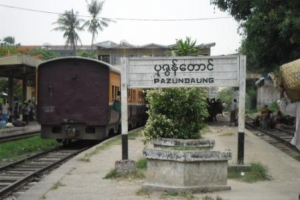
All of these old forms of transportation prepared me for my train loop around Yangon. I boarded, at the downtown station, what has to be one of the oldest, most basic trains that is actually still used as a form of transport rather than being featured in a museum.

The train loop goes from downtown Yangon, out to the countryside, and then completes the circle as it comes back via the other side of Yangon. Each carriage was very basic, with wood benches that ran along the walls and with cut outs where windows used to be, or never were. The loop takes nearly three hours, so there was plenty of time to decide which of the food items being sold by private vendors I wanted to sample. I chose corn, as I wasn’t in the mood for quail eggs and can’t stand the smell of durian. At the city station, on the way out of town, most of the people who boarded the train were looking to get home. However, as the train hit the half way mark out in the countryside, lots of people started to pile on with their goods to take to the markets in the city.
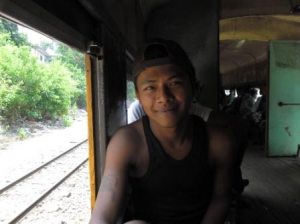

The center of the carriage, which remained empty until the half way mark, suddenly became full of vegetables and fruits. Although it was interesting to see train stops full of produce, to pass by temples along the tracks, and to catch some beautiful views of the countryside I doubt if I will get the urge to make the full 3-hour loop again. The train, although a good experience, is definitely better for shorter journeys.
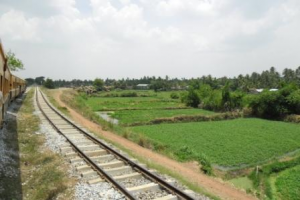
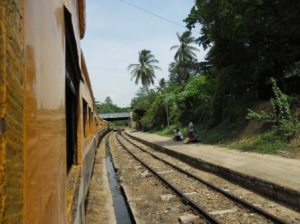
The final form of transportation in Yangon I attempted was walking. People here walk a lot, which is a surprise as, in Cambodia, the huge number of motorbikes is directly related to how little people walk. Walking in Yangon is an adventure in itself. With so many power outages (multiple times a day) there are generators all over the sidewalks. These generators are used to power the air conditioning units in the buildings rising above the road, but people just let the water drip down onto the sidewalk so commonly that it feels like rain even when there is not a cloud in the sky. But the biggest problem I have experienced when walking is that the sidewalks are full of holes that often lead to storm drains below. The atmospheric, crumbling British buildings, remnants of Burma’s colonial past, the new foods street vendors are selling, and the dozens of tea stops that use the sidewalk as their personal floor space are all trying to grab my attention, but I must constantly remind myself to check the ground ahead as that is probably the most dangerous part of being in Yangon.
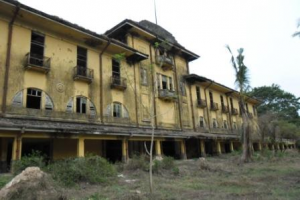
While none of these forms of transport are something Myanmar should be particularly proud of, they are here and they are running and everyday thousands of Burmese use them to go about their daily life and for that reason alone they’re a fun way to take an urban adventure!


